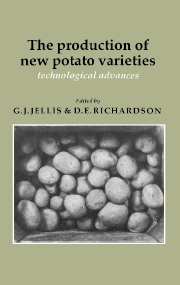Book contents
- Frontmatter
- Contents
- List of contributors
- Preface
- Editors' note and acknowledgements
- Introduction
- The development of potato varieties in Europe
- Genetic Resources
- Breeding Strategies
- Selection and Screening Methods
- The efficiency of early generation selection
- Problems associated with early generation selection of potato clones in West Siberia
- Influence of weight of seed tubers on selection of first year clones: preliminary results
- A joint cyst nematode/late blight test for early generation screening of potato clones
- Screening for resistance to diseases in a potato breeding programme
- Breeding for resistance to potato viruses with special reference to cDNA probes
- Screening for resistance to diseases and pests
- Breeding for resistance to and tolerance of potato cyst nematode
- Breeding multi-resistant potato germplasm
- Resistance to storage diseases in breeding stocks
- Phytophthora research at the Foundation for Agricultural Plant Breeding (SVP)/ The Netherlands
- Effect of time interval between inoculation and assessment on relative content of potato virus YN in leaves of potato plants
- Selection and evaluation of potatoes for improved tolerance of environmental stresses
- Variety Assessment
- Semi-conventional Breeding Methods
- True Potato Seed
- Unconventional Breeding Methods
- Commentary
- Index
The efficiency of early generation selection
Published online by Cambridge University Press: 05 March 2012
- Frontmatter
- Contents
- List of contributors
- Preface
- Editors' note and acknowledgements
- Introduction
- The development of potato varieties in Europe
- Genetic Resources
- Breeding Strategies
- Selection and Screening Methods
- The efficiency of early generation selection
- Problems associated with early generation selection of potato clones in West Siberia
- Influence of weight of seed tubers on selection of first year clones: preliminary results
- A joint cyst nematode/late blight test for early generation screening of potato clones
- Screening for resistance to diseases in a potato breeding programme
- Breeding for resistance to potato viruses with special reference to cDNA probes
- Screening for resistance to diseases and pests
- Breeding for resistance to and tolerance of potato cyst nematode
- Breeding multi-resistant potato germplasm
- Resistance to storage diseases in breeding stocks
- Phytophthora research at the Foundation for Agricultural Plant Breeding (SVP)/ The Netherlands
- Effect of time interval between inoculation and assessment on relative content of potato virus YN in leaves of potato plants
- Selection and evaluation of potatoes for improved tolerance of environmental stresses
- Variety Assessment
- Semi-conventional Breeding Methods
- True Potato Seed
- Unconventional Breeding Methods
- Commentary
- Index
Summary
The most intense selection in many potato breeding programmes is carried out in the early generations. The conditions under which these generations are grown are often not typical of normal agronomic practice. The large number of genotypes that are assessed usually dictates that each genotype is grown in small plots, in many cases at a single location without replication and the “better” clones are identified by visual appraisal. In this study progenies from eight potato crosses were examined. From each cross 70 clones were grown from true potato seed in a glasshouse (GH), in single plant plots in the first clonal year (FCY) and 3-plant plots in the second clonal year (SCY). A random subsample of 25 clones per cross was also grown in 5-plant plots in the third clonal year (TCY). Subject to the availability of tubers, the FCY, SCY and TCY plots were replicated twice at two locations (BB and MURR). After harvest in each year all the plots were visually assessed independently by four potato breeders on a 1–9 scale of increasing desirability. The data presented in this report are the mean scores of the four breeders.
Correlations of mean breeders' preference between the different years' assessment were all found to be significantly greater than zero (Table 1). Scores in the GH correlated most highly with those recorded in the FCY and lowest with those recorded in the TCY. Similarly, the correlation between the FCY and SCY was larger than that between the FCY and TCY.
- Type
- Chapter
- Information
- The Production of New Potato VarietiesTechnological Advances, pp. 72 - 74Publisher: Cambridge University PressPrint publication year: 1987
- 1
- Cited by

